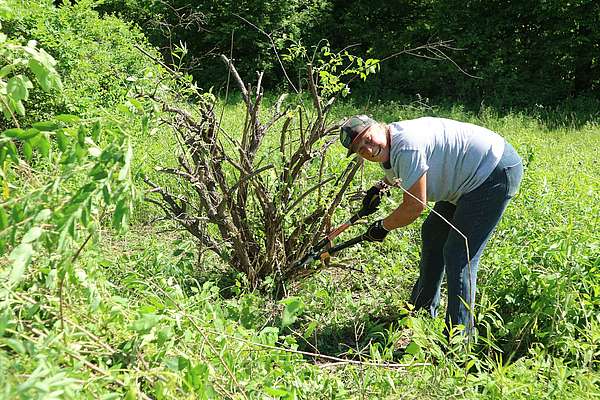We kicked off a multi-year effort to restore native biodiversity and habitats at our 50-acre conserved DuMont Meadow property in Moscow this week. Under the lead of consultant Mike Bald of Got Weeds? and armed with hand saws, loppers, and muscle-power, a group of volunteers uprooted or cut back several hundred mature non-native, invasive bush honeysuckle plants in the meadow. The plan: get rid of the honeysuckle, brushhog the meadow to keep it open, and plant more native trees and shrubs along the Little River. The result will be a mosaic of healthy habitats in small area that collectively attract and support a wide array of native plants and animals.
SLT recently received a grant from the Davis Conservation Foundation to complete the first year of the project. In addition to using a combination of hired professionals and volunteers to knock back the honeysuckle, SLT will be helping to get the word out about the importance of addressing invasive plants in the Stowe community. “Bush honeysuckle, Japanese barberry, garlic mustard and other invasives are in Stowe, but aren’t yet on everyone’s radar,” says Kristen Sharpless, SLT’s ecologist and program manager. “We want people to be able to recognize and address the whole range of invasives in their yards and woods before they become so widespread and severe that it’s too late.”
Fortunately, due to Stowe’s geography and climate, many invasive plants have been slower to take hold here than in other parts of the state. However, you don’t have to travel far to see what is coming our way: large areas of forest that are being overrun by honeysuckle, barberry and other invasive plants. Once this happens, native trees and plants can’t compete and native wildlife suffers. For example, although songbirds eat the bright red berries of honeysuckle and barberry, the fruits lack the nutrition the birds need to thrive and migrate. What looks like a great food source is more like candy or junk food.
In addition to controlling the honeysuckle at DuMont Meadow now before it spreads, SLT is committed to doing so without using herbicides. “We want to show that with a well-informed plan, mechanical control methods are viable for use on organically certified land and for those landowners who have concerns about the potential adverse effects of herbicides on human health, wildlife, and water quality,” said SLT Executive Director, Caitrin Maloney. Using hand and machine-powered methods will take a longer-term commitment, but we think that, in this case, it’s achievable and well worth it. “We feel good about taking a conservative approach and not adding chemicals into the ecosystem that could have unintended harmful impacts,” said Maloney.
We will continue to cut back and pull honeysuckle at DuMont Meadow this year and plans to brushhog the meadow at the end of the growing season after breeding songbirds have left for the winter. To learn more about identifying and controlling invasive plants and pests in Vermont, visit www.vtinvasives.org We will be hosting more volunteer work days and tours of the project. Contact Kristen Sharpless at kristen@stowelandtrust.org or 802.253.7221 for more information or to volunteer.
